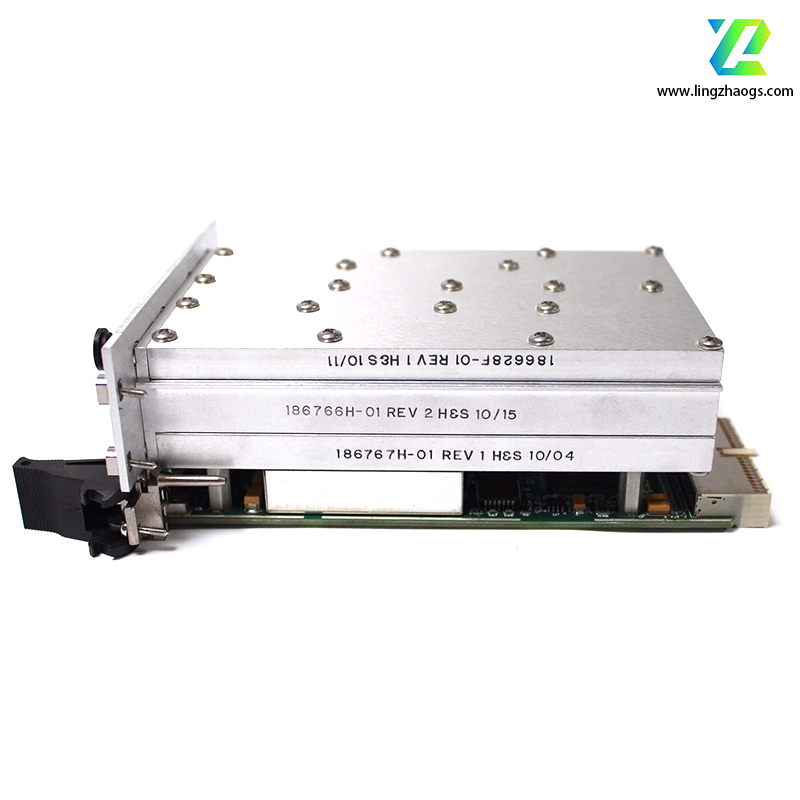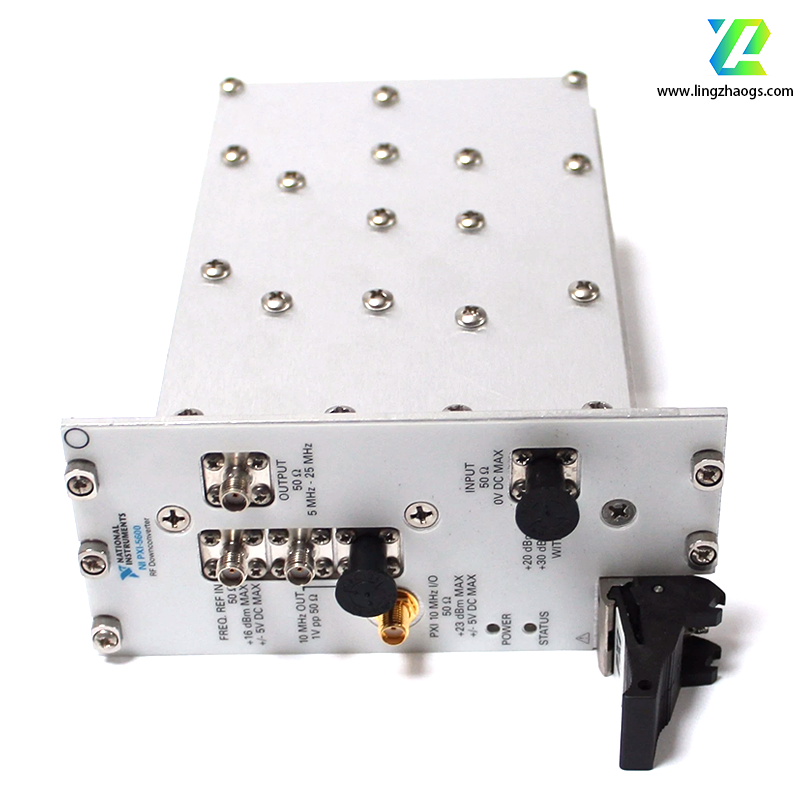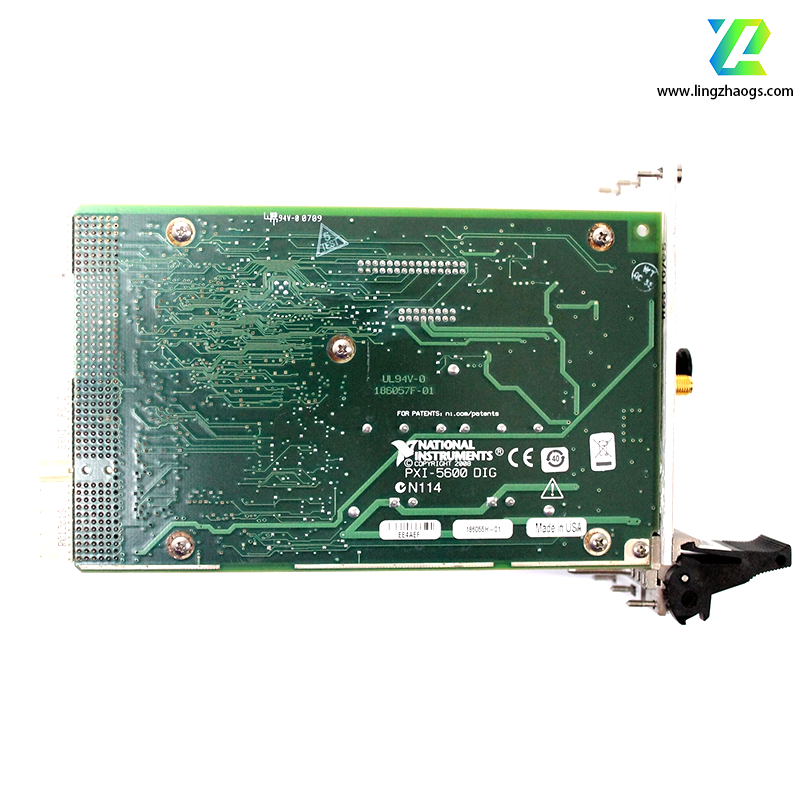The NI PXIe-5600 is an entry-level, high-value vector signal analyzer (VSA) designed for the PXI Express (PXIe) bus architecture, belonging to National Instruments (NI)’s RF test product line. Its defining features include 1 GHz maximum RF input frequency, 12-bit ADC resolution, and compact 1-slot PXIe form factor—making it ideal for cost-sensitive, mid-frequency RF testing scenarios such as wireless IoT device validation, consumer electronics RF calibration, and educational laboratory use. With integrated signal processing and PXIe modularity, it balances performance and affordability for R&D and low-volume production.
- Module Series: PXIe Entry-Level Vector Signal Analyzer (VSA)
- Part Number: 780573-01 (standard model)
- Physical Dimensions: 1-slot 3U PXIe form factor, 10.0 cm × 16.0 cm (width × length)
- Weight: Approximately 0.6 kg (1.32 lbs)
- Power Requirements:
- +3.3 V DC (1.5 A)
- +12 V DC (2.0 A)
- -12 V DC (0.3 A)
- Power consumption: Typical 25 W, Maximum 35 W
- Interface Type:
- PXIe x1 lane (up to 8 GB/s data transfer rate) for real-time data streaming
- 1 SMA female connector (RF input) for single-ended RF signal acquisition
- 1 10-pin header for auxiliary trigger I/O (TTL-compatible)
- Operating Temperature Range: 0°C ~ 55°C (commercial grade)
- Environmental Ratings:
- Shock Resistance: 50 g peak (11 ms duration, half-sine)
- Vibration Resistance: 2 g RMS (10 Hz ~ 500 Hz, random)
- Ingress Protection: IP30 (prevents solid foreign object intrusion)
- Compliance: Meets FCC Part 15 Class A, CE EN 61326-1, UL 61010-1, and IEC 61010-1 safety & EMC standards
- Frequency Range: 9 kHz ~ 1 GHz (continuous coverage, no gaps)
- Input Configuration:
- Single-ended RF input channel
- Input impedance: 50 Ω (standard, matched for RF signals)
- Input return loss: ≥15 dB (300 MHz ~ 1 GHz, typical)
- Input Power Handling:
- Maximum safe input power: +20 dBm (100 mW)
- Damage level: +30 dBm (1 W, 1 minute)
- Noise Performance:
- Noise Figure (NF): ≤12 dB (500 MHz, 1 MHz bandwidth, typical)
- Phase Noise: -105 dBc/Hz (500 MHz carrier, 10 kHz offset, typical)
- Dynamic Range:
- Spurious-Free Dynamic Range (SFDR): ≥65 dBc (500 MHz, 1 MHz bandwidth, typical)
- Third-Order Intercept Point (IP3): +8 dBm (typical, at 500 MHz)
- ADC Resolution: 12-bit (successive approximation register, SAR)
- Sampling Rate:
- Maximum real-time sampling rate: 62.5 MS/s
- Equivalent Time Sampling (ETS): Supported for signals up to 1 GHz (extends bandwidth beyond real-time sampling)
- Bandwidth Options:
- Baseband bandwidth: Up to 20 MHz (real-time, at 62.5 MS/s sampling)
- Decimation filters: Programmable (1x, 2x, 4x) to reduce bandwidth and improve noise performance
- Quantization Noise: -67 dBFS (typical, at full-scale input, 1 MHz bandwidth)
- Modulation Analysis: Supports common low-to-mid speed digital modulation formats, including:
- IoT/Wireless LAN: LoRaWAN, Sigfox, Bluetooth Low Energy (BLE), Wi-Fi 4/5 (802.11b/g/n)
- Cellular: GSM, GPRS, EDGE (2G/2.5G)
- General: ASK, FSK, PSK, QAM (up to 256-QAM)
- Key Measurements:
- Power: Average, peak, peak-to-average (PAPR), channel power
- Modulation Quality: EVM (Error Vector Magnitude), phase error, amplitude error, constellation diagram
- Spectral Analysis: Occupied bandwidth, adjacent channel power ratio (ACPR), spurious emissions
- Time-Domain Analysis: Pulse width, rise/fall time, envelope tracking (for pulsed RF signals)
- Onboard Processing:
- Basic FPGA-based signal preprocessing (filtering, downconversion)
- Supports offloading complex analysis to host PC (via PXIe) for flexible, software-defined measurements
- Clock Sources:
- Internal: 100 MHz TCXO (Temperature-Compensated Crystal Oscillator), stability ±1 ppm/year
- External: 10 MHz reference input (via auxiliary header) for system-wide timing alignment
- PXIe 10 MHz Backplane Clock: Synchronizable with other PXIe modules (e.g., signal generators, DAQs)
- Trigger Options:
- RF Edge Trigger: Rising/falling edge on RF input (threshold adjustable: -40 dBm ~ +10 dBm)
- Digital Trigger: TTL-compatible edge on auxiliary trigger I/O or PXIe trigger lines (PXIe_Trig 0~7)
- Software Trigger: API-initiated trigger for automated test sequences
- Multi-Module Sync:
- Basic synchronization via PXIe 10 MHz backplane clock (for multi-channel testing with other PXIe-5600 modules)
- Compatible with NI PXIe-5670/5671 signal generators for closed-loop test systems
- Recommended Software:
- NI RFmx Measurement Suite (entry-level package, for modulation analysis and basic spectral measurements)
- LabVIEW 2018+ (for custom test program development and GUI design)
- NI TestStand (for test sequence automation and report generation)
- Drivers:
- NI-RFSA (RF Signal Analyzer driver) for low-level hardware control and measurement configuration
- Compatible with NI-FGEN driver (for integration with signal generator modules)
- Programming Compatibility:
- NI Ecosystem: Native support for LabVIEW, LabWindows/CVI, and Measurement Studio
- Third-Party Languages: Supports C/C++, C#, Python (via NI-RFSA Python bindings), and MATLAB (via NI-RFSA Toolbox)
- Scripting: Supports Python and LabVIEW scripting for rapid test setup (e.g., batch calibration of IoT devices)
- Calibration Tools:
- Built-in automated calibration (via NI RFmx) for gain, offset, and linearity correction
- Recommended calibration interval: 1 year (or after major temperature changes)
- External calibration support via NI Calibration Services
The NI PXIe-5600’s balance of performance and cost makes it ideal for:
- IoT Device Testing: Calibration and validation of low-power wireless IoT modules (LoRaWAN, Sigfox, BLE), including RF power measurement and modulation quality (EVM) analysis
- Consumer Electronics: RF testing of smart home devices (Wi-Fi 4/5 routers, Bluetooth speakers), and mobile phone 2G/3G auxiliary signal validation
- Educational Labs: RF principle teaching (spectral analysis, modulation/demodulation) and student projects (simple radar, wireless communication prototypes)
- Industrial Wireless: Testing of industrial IoT (IIoT) sensors (WirelessHART, Zigbee) used in factory automation and process control
- Low-Volume Production: Cost-sensitive production test of low-frequency RF components (e.g., RFID tags, remote control modules)
- Ideal Use Cases: Applications requiring 1 GHz RF coverage, 20 MHz real-time bandwidth, and low cost; suitable for entry-level RF testing, education, and IoT/consumer electronics
- Comparison with Similar Models:
- vs. NI PXIe-5632: PXIe-5600 offers lower frequency range (1 GHz vs. 3.6 GHz) and resolution (12-bit vs. 14-bit) but lower cost; choose for budget-sensitive, mid-frequency tasks
- vs. NI USB-5600: PXIe-5600 has PXIe bus (vs. USB) for better integration with modular systems; ideal for multi-instrument test setups
- System Integration:
- Chassis Compatibility: Works with all NI PXIe chassis (e.g., PXIe-1075, PXIe-1082) and third-party PXIe-compliant chassis
- Companion Modules:
- Signal Generation: Pair with NI PXIe-5670 (1 GHz vector signal generator) for closed-loop test systems
- Signal Conditioning: Use NI PXIe-5690 (RF preamplifier) to improve weak signal detection (reduces NF by 5 dB)
- Switching: Integrate with NI PXIe-2543 (RF multiplexer) for multi-DUT testing
- Limitations: Real-time bandwidth limited to 20 MHz (insufficient for wideband signals like 5G NR); 12-bit ADC (higher quantization noise than 14-bit models)
- Alternative Models:
- Higher Frequency: NI PXIe-5632 (3.6 GHz, 14-bit)
- Higher Bandwidth: NI PXIe-5665 (3 GHz, 1 GHz bandwidth)
- USB Interface: NI USB-5600 (identical performance, for standalone use)





